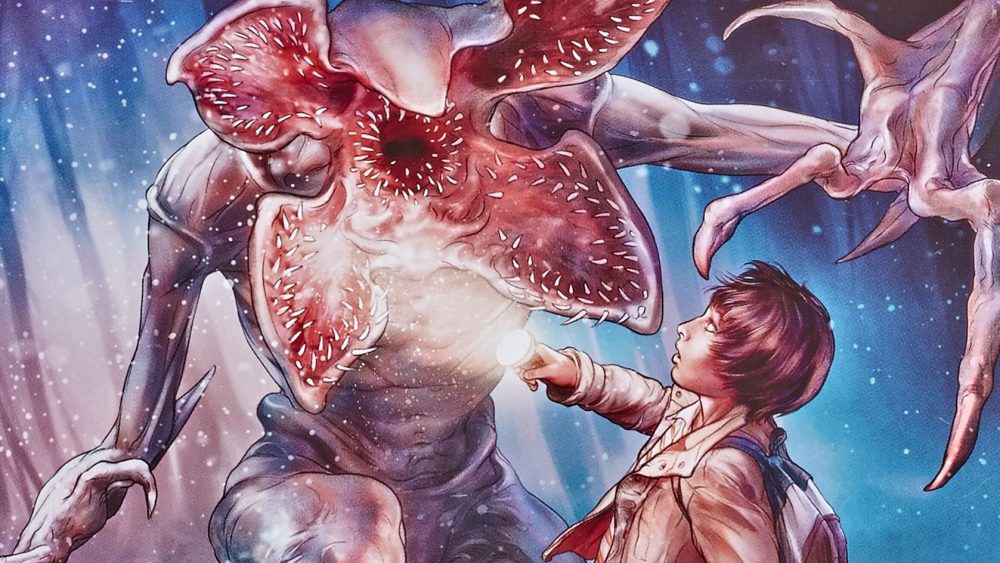
Despite having 45 years of history, revisions and different rulesets under its belt, getting into Dungeons & Dragons remains intimidating for many. Between the dense rulebooks and multifaceted character sheets, on-boarding new players has ever been the game’s most significant hurdle. It’s not a great look when accessing The Fun Part of your game means cross-referencing a heavy rulebook to fill out a sheet. For most, it has the texture of homework and once that correlation is made, it’s hard to escape it.
D&D publisher Wizards of the Coast attempted to tackle this problem in the original Starter Set for the game’s current Fifth Edition (referred to as 5e) ruleset with mixed success. With this year’s Stranger Things Starter Set, they are taking another stab at it.
The original Starter Set included everything a group might need to get a game off the ground: a set of polyhedral dice, a clutch of premade character sheets, a Basic Rules booklet and The Lost Mine of Phandelver, a short but exciting quest in the vein of classic Second Edition (2e) adventure modules. The Stranger Things Starter Set follows a similar lead — it also contains dice, premade character sheets, the basic rules booklet for older readers and a short adventure with a classic feel — but also makes a few important changes.
The first and most obvious change is the pivot from a standard D&D adventure to a tie-in with a popular brand known for its connection to the game. The popular Netflix series Stranger Things famously began its first season with its main characters in the middle of their regular D&D game. The adventure contained within the Stranger Things Starter Set, called Hunt for the Thessalhydra, is based on that in-universe game. The module is presented as if you’ve stumbled upon a campaign notebook owned by Mike Wheeler, hand-written on a yellow legal pad, complete with hand-drawn maps and character sketches. It even comes in a facsimile of the classic Red Box basic set from 1983.
Like Phandelver, Thessalhydra is vintage D&D. The players are charged by the gallant Sir Tristan with finding and slaying the Thessalhydra, a mysterious beast terrorising a small farming town. The players will need to interact with the townsfolk to gear up and gather information on the beast — including learning to separate fact from fiction — in order to begin their hunt. Adventure, intrigue, horror — all the ingredients of a classic D&D yarn, interspersed with story beats and locations familiar to fans of the show, including the Upside Down. You’re free to lean into any of these aspects that appeal to you — make it a rollicking, kick-in-the-door-and-slay-the-beast adventure or ratchet the kind of Goosebumps-style spooky drama that kids eat up.
The Starter Set presents a broad introduction to the game’s mechanics for players, but the original version still threw Dungeon Masters in at the deep end, the seeming assumption being that the reader was not only a grown-up but someone who had prior experience. In Dungeons & Dragons, the Dungeon Master (or DM) is the person responsible for making the entire game tick over. Equal parts narrator, puppetmaster and referee, the DM controls not only the world the players inhabit but every character they meet and every monster they battle. They set the challenge and decide on the consequences of player actions.
Being the DM isn’t easy, but it is rewarding. Where the Dungeon Master’s Guide preaches to the choir and speaks to those who’ve run games before, the Stranger Things Starter Set is an open invitation to anyone, young or old, to get behind the screen. Mike’s adventure is laid out in simple terms. It hints at the types of players you might encounter and how to prepare for them. It keeps its reference points simple — if an enemy’s name is underlined, you know to turn to the Monsters section at the back of the booklet for more information. It breaks down how to read D&D maps and ways to describe what’s in each room to your players. It explains what challenge ratings and difficulty classes are, and how they can be applied to any adventure, not just Thessalhydra.
What I like the most is that it starts planting the seeds of D&D’s innately expandable design right away. “Don’t worry too much about getting the rules right or being perfect as a DM,” reads Mike’s introduction. “Just relax, let things happen naturally, and enjoy playing the game. If things get confusing — especially in combat — do what seems fair and move on.” Dungeons & Dragons is at its best in moments when certain rules are bent or waived entirely to accommodate the shape of the game at hand. This facet of the game, with all its complex rulebooks and sheets and charts and numbers, has always been the hardest to communicate to new players. You can simply throw rules away if everyone agrees on it. Rewrite the entire Thessalhydra adventure if you want. It’s your game. Play it how you like. There are no wrong answers in D&D. To see WotC baking that truism, especially for a younger crowd who might be turned off by the hundreds of rules, is fantastic.
The Stranger Things Starter Set is about as perfect an entry point for Dungeons & Dragons as its possible to find. A big, well-known IP, an easy setup process, and a succinct explanation of how to play and how to run that anyone can understand. With on-boarding this strong, D&D’s modern resurgence will continue for years to come, and bring an entirely new generation into the tabletop RPG fold.
Many thanks to Hasbro Australia and Wizards of the Coast for supplying us with a retail copy of the Stranger Things Starter Set. It has an RRP of AUD $39 and is available at your friendly local game shop.
